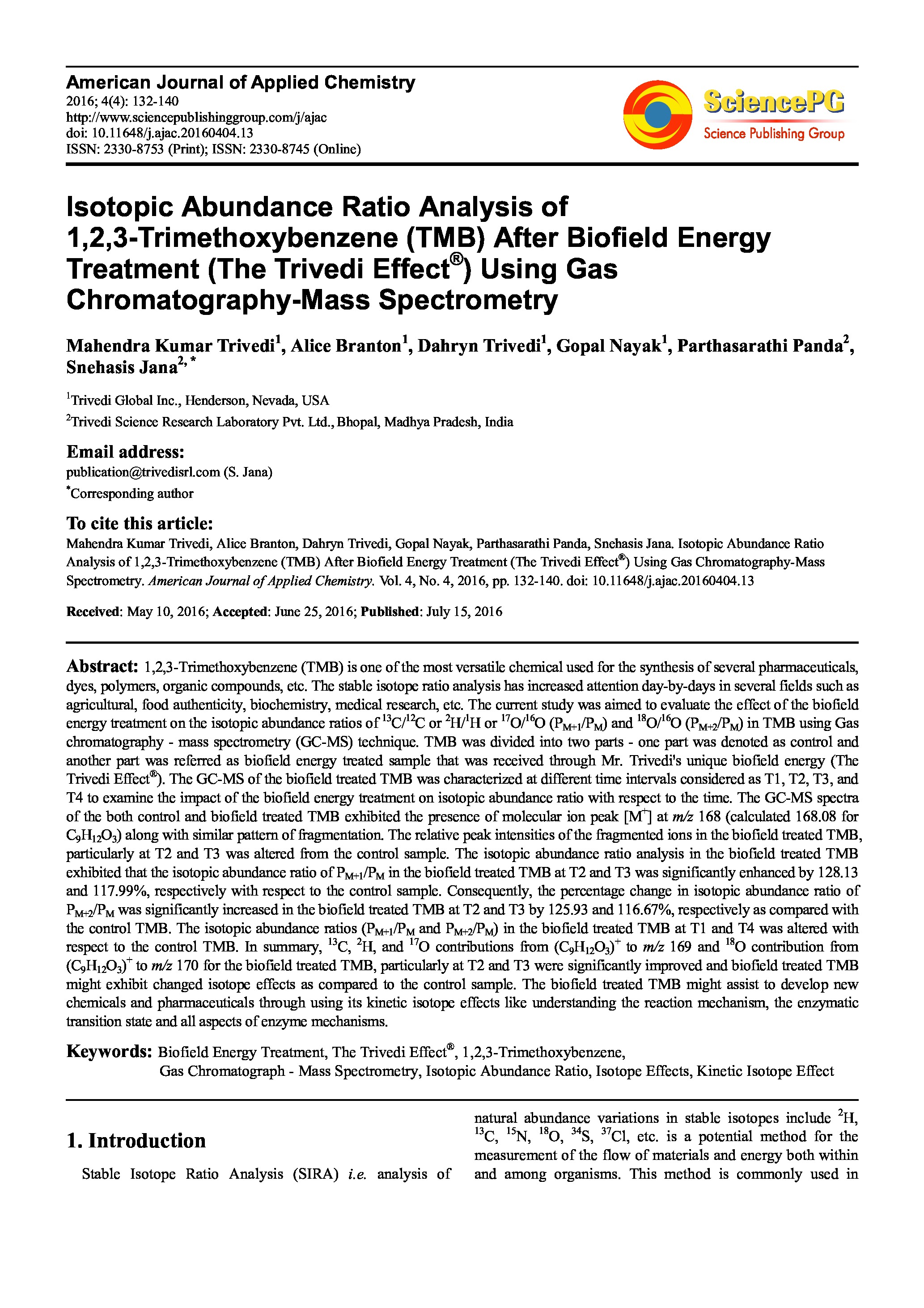Isotopic Abundance Ratio Analysis of 1,2,3-Trimethoxybenzene (TMB) After Biofield Energy Treatment (The Trivedi Effect®) Using GC-MS
Affiliation
Trivedi Global Inc.; Trivedi Science Research Laboratory Pvt. Ltd.
Main category
Natural Sciences (Analytical Chemistry, Method Development (Chemistr)
Abstract
1,2,3-Trimethoxybenzene (TMB) is one of the most versatile chemical used for the synthesis of several pharmaceuticals, dyes, polymers, organic compounds, etc. The stable isotope ratio analysis has increased attention day-by-days in several fields such as agricultural, food authenticity, biochemistry, medical research, etc. The current study was aimed to evaluate the effect of the biofield energy treatment on the isotopic abundance ratios of 13C/12C or 2H/1H or 17O/16O (PM+1/PM) and 18O/16O (PM+2/PM) in TMB using Gas chromatography - mass spectrometry (GC-MS) technique. TMB was divided into two parts - one part was denoted as control and another part was referred as biofield energy treated sample that was received through Mr. Trivediꞌs unique biofield energy (The Trivedi Effect®). The GC-MS of the biofield treated TMB was characterized at different time intervals considered as T1, T2, T3, and T4 to examine the impact of the biofield energy treatment on isotopic abundance ratio with respect to the time. The GC-MS spectra of the both control and biofield treated TMB exhibited the presence of molecular ion peak [M+] at m/z 168 (calculated 168.08 for C9H12O3) along with similar pattern of fragmentation. The relative peak intensities of the fragmented ions in the biofield treated TMB, particularly at T2 and T3 was altered from the control sample. The isotopic abundance ratio analysis in the biofield treated TMB exhibited that the isotopic abundance ratio of PM+1/PM in the biofield treated TMB at T2 and T3 was significantly enhanced by 128.13 and 117.99%, respectively with respect to the control sample. Consequently, the percentage change in isotopic abundance ratio of PM+2/PM was significantly increased in the biofield treated TMB at T2 and T3 by 125.93 and 116.67%, respectively as compared with the control TMB. The isotopic abundance ratios (PM+1/PM and PM+2/PM) in the biofield treated TMB at T1 and T4 was altered with respect to the control TMB. In summary, 13C, 2H, and 17O contributions from (C9H12O3)+ to m/z 169 and 18O contribution from (C9H12O3)+ to m/z 170 for the biofield treated TMB, particularly at T2 and T3 were significantly improved and biofield treated TMB might exhibit changed isotope effects as compared to the control sample. The biofield treated TMB might assist to develop new chemicals and pharmaceuticals through using its kinetic isotope effects like understanding the reaction mechanism, the enzymatic transition state and all aspects of enzyme mechanisms.
DOI
10.18147/smn.2017/paper:496
Do you have problems viewing the pdf-file? Download paper
here
If the paper contains inappropriate content, please
report the paper. You will be redirected to the landing page.
